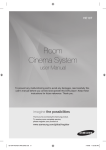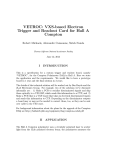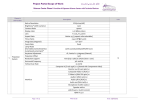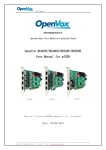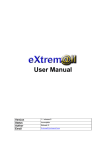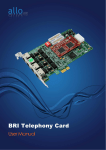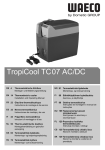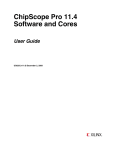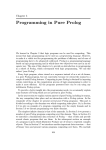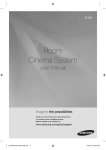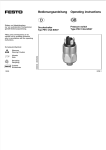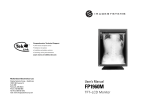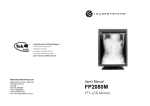Download The MAGIC Level 2 Trigger A User`s Manual R. Paoletti - GAE
Transcript
MAGIC-TDAS 03-04 000220/RPaoletti The MAGIC Level 2 Trigger A User’s Manual R. Paoletti <[email protected]> Version 1 June 16, 2003 Abstract This document is the user’s manual for the MAGIC Level 2 Trigger. The interface program features are described and details on the trigger programming are given. Contents 1 Introduction 2 2 Level 1 Trigger 3 3 Level 2 Trigger 3.1 The SMART Boards . . . 3.2 The PRESCALER Board 3.3 The SCALER Board . . . 3.4 The DIGITAL I/O Board . . . . . . . . . . . . . . . . . . . . . . . . . . . . . . . . . . . . . . . . . . . . . . . . . . . . . . . . . . . . . . . . . . . . . . . . . . . . . . . . . . . . 4 Calibrations 3 4 6 8 9 9 5 Trigger Rates 10 6 The L2T Interface Program 10 7 Programming L2T 7.1 The Main Menu . . . . . . . . . . . . . . . . . . . . . . . . . . . 7.2 The SMART Menu . . . . . . . . . . . . . . . . . . . . . . . . . 7.3 The PRESCALER Menu . . . . . . . . . . . . . . . . . . . . . 12 13 14 15 1 Introduction 1 2 Introduction The trigger system of the MAGIC telescope is made by: • a Level 1 Trigger (L1T), that looks for fast coincidences of next-neighbours pixels; • a Level 2 Trigger (L2T) that performs a more sophisticated analysis of the shower image. The trigger area is partially covering the inner camera surface composed by 397 photomultipliers, also called pixels. In order to ensure a full efficiency at Level 1 even for 5 next neighbour pixels, the trigger cells are overlapping as shown in figure 1. A set of 37 pixels is called macrocell, the unit for the trigger system. The L1T system is based on this segmentation and its logic is defined as a combination of the macrocell pixels. One pixel out of 37, the “blind pixel”, is not wired into the trigger logic, so the macrocell logic is built on 36 pixels. The blind pixel is shown as a solid hexagon in figure 1 and marked as “X” in figure 3. Figure 1: The trigger coverage on the MAGIC camera. 2 Level 1 Trigger 3 bit data 0 0 1 global L1 trigger 2 TBD 3 TBD 4 TBD 5 TBD 6 TBD 7 TBD calibration 1 TBD TBD TBD TBD TBD TBD TBD Table 1: Definition of the trigger word (preliminary). The whole trigger system architecture is sketched in figure 2. On the leftmost side the 19 L1T cells are visible. Upon a valid L1T, the digital information is transferred to the L2T that is arranged in a tree structure in order to transfer the information to next layers and to apply topological cuts on the shower image. The L2T system does not output a single signal but an 8-bit word where the trigger information can be coded. At the time of this writing, the trigger word coding is not defined. A preliminary definition is in table 1. 2 Level 1 Trigger The L1T boards are custom electronic boards housed in the trigger rack. The signals coming from the discriminators are fed into the L1T backplane (rear of the crate) according to the scheme that is sketched on the front panel of the L1T crate. Each cable transports 8 LVDS differential signals. The L1T boards perform a logic combination of the input signals to look for clusters of 2, 3, 4 or 5 neighbour pixels, according to TTL levels on the “fold selector inputs”, located on the front panel. The fold selection is done by the L2T interface as explained in section 3.4. The DB9 connector on the L1T boards outputs the 2, 3, 4 and 5 logic combinations that are sent to the TPU (Trigger Processing Unit), located on top of the trigger rack. The purpose of the TPU board is twofold: • to select the fold combination for rates measurement; • to fan out the fold selection levels to the L1T boards. The Global OR of the L1T boards is sent to a LEMO-00 connector as a TTL signal. DO NOT use this signal as an alternative trigger source because the level and timing are not compatible with the FADC system. 3 Level 2 Trigger The L2T is an asynchronous system made by electronic boards called SMART, with on-board Look Up Tables (LUTs), arranged in a tree-like structure, see figure 2. In this section we review the 3.1 The SMART Boards Figure 2: Scheme of the L2T system. The L1T boards are shown on the left. characteristics of the electronic boards. A description of the trigger implementation can be found in [3]. 3.1 The SMART Boards The SMART is a 6U board, mechanically and electrically compatible with the VME bus. The input signals are LVDS levels. The 36 input signals are split in three 12-bit words. Every LUT outputs a 5 lines bus. The buses coming from the three LUTs are grouped in a 15 bit bus as the input of the fourth LUT. The contents of a LUT are downloaded by the L2T interface program. The address scheme used for the SMART boards is reported in the following table: The first 19 SMART boards are located on the bottom VME crate of the trigger rack. There is a one-to-one correspondence between these SMARTs and the L1 boards. 4 3.1 The SMART Boards 5 SPECIFICATIONS VME access Address Package Memory Depth INPUT SIGNALS INPUT SIGNALS LVDS OUTPUT SCALER TTL TRG OUT INTERNAL REGISTERS LUT1 LUT2 LUT3 LUT4 PATTERN A24/D16 dip-switches 6U three 12-bit SRAM, one 15-bit SRAM 3*4096 bytes, 32768 bytes 36 differential LVDS levels, SCSI HD connector 9 channels TTL level, 20 pin header differential ECL signal Base address for LUT #1 Address: BASE+0x00000000, R/W, D16 Base address for LUT #2 Address: BASE+0x00010000, R/W, D16 Base address for LUT #3 Address: BASE+0x00020000, R/W, D16 Base address for LUT #4 Address: BASE+0x00030000, R/W, D16 Output pattern register Address: BASE+0x00040000, W, D16 Writing an 8-bit word into the PATTERN register will produce the same pattern on the output connector. Used for debugging. Table 2: Specifications for the SMART board SMART #1 #2 ... # 14 # 15 # 16 # 17 ... # 23 # 24 Address (HEX) 0x0010 0000 0x0020 0000 ... 0x00E0 0000 0x00F0 0000 0x0008 0000 0x0018 0000 ... 0x0078 0000 0x0088 0000 Table 3: Address scheme of the SMART boards 3.2 The PRESCALER Board 6 Figure 3: Pinout inside a SMART 3.2 The PRESCALER Board The PRESCALER board is used in the MAGIC telescope to prescale the triggers coming from the L2T in order not to fill the maximum DAQ bandwidth. Its characteristics are: • large prescale interval (0 - 65535) • capability to handle trigger and calibration signals The PRESCALER is a 6U board, mechanically and electrically compatible with the VME bus. • REGISTER - these registers contain the prescaler values for the 8 input channels. • ENABLE - This register contains the enable mask for the 8 input channels. Writing 0 in a given position disables the corresponding channel. Writing 1 will enable the channel. bit channel 15 · · · 8 X 7 7 6 6 5 5 4 4 3 3 2 2 1 1 0 0 3.2 The PRESCALER Board SPECIFICATIONS Package VME access Address INPUT SIGNALS INPUTS BUSY WR ZERO OUTPUT SIGNALS TRGOUT WR FIFO WR FIFO WR FIFO OUTPUT PATTERNS INTERNAL ADDRESSES REGISTER ENABLE RESET CLEAR 7 6U A24/D16 dip-switches 8 channels LVDS, one 20 pin 3M-3WALL connector ECL signal, LEMO-B connector ECL signal , LEMO-B connector ECL signal, LEMO-B connector ECL signal, LEMO-B connector ECL signal, LEMO-B connector ECL signal, LEMO-B connector 16 channels LVDS, two 40 pins 3M-3WALL connectors Address: Address: Address: Address: BASE+0x0002*n, R/W, D16 (n = 0, 7) BASE+0x0010, R/W, D16 BASE+0x0012, WRITE ONLY, D16 BASE+0x0014, WRITE ONLY, D16 Table 4: Specifications for the PRESCALER board 3.3 The SCALER Board SPECIFICATIONS Package Count Accuracy Time Accuracy VME access Address Memory INPUT SIGNALS INPUTS VETO EXT CLOCK CLEAR TEST 8 6U VME board 32 bits equivalent to 4 Giga counts max. 20 ns, time window selected by a 32 bit word A32/D32, A24/D16 rotary-switches double buffer 80 channels LVDS/TTL, two 3M-3WALL connectors LVDS signal, LEMO-B connector LVDS signal, LEMO-B connector LVDS signal, LEMO-B connector LVDS signal, LEMO-B connector Table 5: Specification for the SCALER board • RESET - Accessing this register will reset the count registers. • CLEAR - Accessing this register will clear the prescaler registers. 3.3 The SCALER Board The SCALER board is used in the MAGIC telescope to measure the pixels trigger rates and to monitor the dead and live time of the experiment. Its features are: • 80 input channels (LVDS/TTL) • accurate rates count (32 bits, 4 Giga counts max) • dead and live time measurement (64 bit words) • counts measurement in a variable time interval in 20 ns bins (for a 50 MHz internal clock) The SCALER is a 6U board, mechanically and electrically compatible with the VME bus. The input signals can be either LVDS or TTL levels. They can be defined by soldering the appropriate converters/drivers on the board. The VME addressing is A24/D16 for control registers and A32/D32 for data registers. The board accepts signals on its front panel. • INPUTS - the 80 inputs are divided in two connectors, 3M-3432-3Wall/3Wall. The inputs can be either LVDS or TTL levels. Depending on the choice, LVDS translators or TTL buffers are mounted on board. • VETO - is the BUSY signal coming from the FADC system. When this signal is high, counts are disabled. • EXT CLOCK - is a strobe signal used in place of the internal timing signal given by the 50 MHz oscillator. An internal register is used to select between internal and external trigger. 3.4 The DIGITAL I/O Board 9 SPECIFICATIONS Package VME access Address INTERNAL REGISTERS 3U VME board A16/D16, A16/D8 dip-switches Table 6: Specifications for the DIGITAL I/O board fold 2 3 4 5 pattern (binary) 001 010 011 100 description 2 3 4 5 NN NN NN NN logic logic logic logic Table 7: Logic for the L1 fold selection • CLEAR - is an external signal that resets all the counters • TEST - increments all the counters regardless of the VETO signal. Mainly used for debugging. This board is currently being designed and its internal registers are not yet defined. Open question. If the dead and live time have to go into the data stream, this information has to be latched with the trigger by the Digital Modules. This means that one of the SCALER boards has to be programmed as an output register, i.e. it has to output the register contents on the 3M connectors upon every EXT CLOCK, in this case the L2 trigger. The register contents (64 bits) require four DMs for the dead time and other four for the live time information. 3.4 The DIGITAL I/O Board The DIGITAL I/O board is a commercial VME board (VMIC xxx). It is a double parallel port board, with I/O capability and internal timers. It is used in the L2T framework as a digital output board to drive the fold selector connector on the L1 boards. The board outputs a TTL pattern that goes to the “Fold Selector” input of the TPU board (see table 7). 4 Calibrations Twelve lines of the L2T system are available for calibration purposes (figure 2). The interface between the L2T system and the calibration lines is given by the L2T SMART interface board, called L2Link. Calibrations are merged together with the outputs of SMARTs # 20, 21, 22 and 23 into the last SMART board (#24). 5 Trigger Rates 10 signal signal signal signal signal signal 1 2 3 4 5 6 (+) (+) (+) (+) (+) (+) NC NC NC NC pin pin 1 2 3 4 5 6 7 8 9 10 11 12 13 14 15 16 17 18 19 20 signal signal signal signal signal signal NC NC NC NC 1 2 3 4 5 6 (-) (-) (-) (-) (-) (-) Table 8: Connector pinout for calibration signals # 1-6. A similar scheme is valid for calibration lines # 7-12. The calibration signals have to be made available to the L2T system as LVDS levels on two connectors of the L2link board. They travel through two 20-lines twisted pair flat cables and connect to the L2Link with a polarized 2 × 10 header connector according to the scheme described in table 8. This plug connector goes into a receptacle similar to that one used for the Digital Modules [2]. Any signal on pins 13-14 and 15-16, marked as NC, can be sent to an output connector and to scalers for calibration monitor. If you are not interested in this feature just leave them unconnected. 5 Trigger Rates The trigger rates are measured by a commercial VME board (CAEN V791?) accepting 32 LVDS input signals. It is used mainly to measure the rates of the L1T macrocells. These signals are coming from the L1 TPU board, located on top of the trigger rack. A list of the trigger rates reported to Central Control is contained in table 9. This definition is used in the commissioning phase and has to be cosidered as temporary. It may change in the future. 6 The L2T Interface Program To start the program do the following: 1. Log on the trigger machine (PC11) as trigger. 2. Go in the programs directory cd programs 3. start the trigger interface trigger or ./vmetest. 6 The L2T Interface Program pin 1 2 ··· 18 19 20 21 22 23 24 25 26 27 28 29 30 31 32 11 description L1T macrocell # 1 L1T macrocell # 2 ··· L1T macrocell # 18 L1T macrocell # 19 L2T prescaled triggers L2T unprescaled triggers # 1 calibration # 1- PED calibration # 2 - CAL calibration # 3 - PIND not used not used not used not used not used not used not used not used Table 9: Temporary definition of the trigger rates list 7 Programming L2T 12 The interface is based on a kernel program which performs all basic operations on the VME boards. When it was created, a long time ago, this program was named vmetest. The program interface has changed a little during the time but the kernel program has remained the same along with its name. The program can work in stand-alone mode or CC mode, waiting for commands from the Central Control via TCP sockets. For more informations about the communication protocol between the L2T and Central Control see [1]. Under normal circumstances, the users should interact with the L2T via the Central Control only. 7 Programming L2T This section describes the details of the L2T programming. Experts only are allowed to use this program and to change configuration files. A misuse of this program may lead to malfunctions in the trigger system. The trigger interface is a C program based on simple actions called verbs. A menu is a collection of verbs. The list of verbs can be obtained by typing a question mark (?) at the menu prompt. A verb can be shortened as long as the word is not ambiguous. Several verbs can be inserted in a text file called macro. The definition of menus are contained in the file vmetest define.uic. At startup the programs executes a macro file called vmetest init.uic. An example of the startup macro file is: ! ! This is vmetest_init.uic ! set log_path log log_file on table_path tables async yes HostName pc1.magic.iac.es HostNo 8000 PortNo 8001 status idle return ! smart init select 15 table sp 0 1 sp 1 1 sp sp 6 1 sp 7 1 sp sp 12 1 sp 13 1 sp sp 18 1 sp 19 1 sp sp 24 1 sp 25 1 sp sp 30 1 sp 31 1 sp 2 8 14 20 26 32 1 1 1 1 1 1 sp sp sp sp sp sp 3 9 15 21 27 33 1 1 1 1 1 1 sp sp sp sp sp sp 4 10 16 22 28 34 1 1 1 1 1 1 sp sp sp sp sp sp 5 11 17 23 29 35 1 1 1 1 1 1 7.1 The Main Menu 13 out f 0 0 0 print return return ! prescaler address f000 return The vmetest init.uic macro file is used to set default values for the program. Direct actions on VME are not expected to be written in this file in order not to perturb the trigger system state. This allows to run more than one program without initial interference on the system, e.g. to perform remote monitoring. 7.1 The Main Menu The list of verbs available from the main menu is: -------------------------------------------------------------------------------Trigger Main Menu 1 2 3 4 5 6 7 8 9 10 11 12 13 14 15 16 17 18 19 20 [CONNECT] [DISCONNECT] [START] [STOP!] [LOADT] [RATES] [RATE!] [RATIM] [LOCK!] [ULOCK] [ADIOS] [SET] [SMART] [PRESCALER] [VME] [LOOP] [MESSAGE] [SYSTEM] [WAIT] [EXIT] Connect to the L2T system Disconnect from the L2T system Enable triggers Disable trigger Load trigger table Turn on trigger reports Turn off trigger reports Set trigger reports interval Lock the L2T control program Unlock the L2T control program Disconnect the L2T system from CC Set Program Parameters Invoke Smart Menu Invoke Prescaler Menu Invoke VME Menu Loop on macro Output a Message Exec system commands Wait some time Back to Shell Here is a brief explanation of the basic verbs. 7.2 The SMART Menu CONNECT DISCONNECT START STOP! LOADT RATES RATE! LOCK ULOCK SMART PRESCALER 7.2 14 connects the interface to host name and port number disconnects the interface from the host enable triggers (executes the macro tables/START TRIGGERS.uic) disables trigger (executes the macro tables/STOP TRIGGERS.uic) used to load a trigger table, e.g. load default starts the trigger rate reports on the trigger console stops the trigger rate reports on the trigger console locks the trigger console, the program listens for commands from the Central Control the program will not execute commands coming from the Central Control will invoke the SMART menu to perform actions on the boards. See next sections. will invoke the PRESCALER menu to perform actions on the boards. See next sections. The SMART Menu The list of verbs available from the SMART menu is: -------------------------------------------------------------------------------Smart Menu 1 2 3 4 5 6 7 8 9 10 11 12 13 14 15 16 17 18 19 20 [SELECT] [ADDRESS] [INIT] [CLEAR] [PATTERN] [CHECK] [LUT] [INPUTS] [OUTPUTS] [TABLE] [DEBUG] [PARSE] [PROGRAM] [FILL] [LOGIC] [DOWNLOAD] [DUMP] [PSSIZE] [SHOW] [RETURN] Select SMART Set SMART Address Init the SMART Board Clear the SMART Board Output a pattern Enable/Disable Clear Check Select the LUT memory Define the input names Define the output names Define the logic strings Turn debugging ON/OFF Parse the logic strings Program the TALU Board Fill memories Program logic into the TALU Board Download file into the TALU Board Dump memory contents to file Apply pseudo size cuts Show the TALU Contents Back to Main Menu The SMART menu can be used to mask trigger macrocells. This can be accomplished by clearing the contents of the corresponding SMART board. In this way, the macrocell will not issue triggers. For example, to mask macrocell # 15 from the trigger logic type: STOP SMART SELECT 15 7.3 The PRESCALER Menu 15 CLEAR RETURN START Always STOP the trigger before any change in the trigger configuration. This is necessary to avoid spurious trigger to be generated when the VME access is going on. The triggers will be stopped at PRESCALER level. The commands can be entered in a more compact way, i.e. STOP SMART SELECT 15 CLEAR RETURN START When the mask is no more needed you can restore the original trigger table, e.g.: STOP LOAD DEFAULT START 7.3 The PRESCALER Menu The list of verbs available from the PRESCALER menu is: -------------------------------------------------------------------------------PRESCALER Menu 1 2 3 4 5 6 7 8 [ADDRESS] [REG_READ] [REG_WRITE] [ENABLE_READ] [ENABLE_WRITE] [CLEAR] [RESET] [RETURN] Specify Prescaler VME Address Read Prescaler Register Write Prescaler Register Read Prescaler Enable Mask Write Prescaler Enable Mask Clear the Prescaler Registers Reset the Prescaler Counters Back to Main Menu This menu can be used to change prescale factors. The prescale registers are a 16 bit word, so the maximum factor that can be downloaded in every register is 65535. For example, to set a prescale factor of 1000 on trigger bit # 0: STOP PRESCALER REG_WRITE 0 1000 RESET RETURN START There is a specific sequence of operations to perform in order to arm the prescaler. References 16 1. STOP the triggers, by writing ENABLE WRITE 0 2. CLEAR the prescale registers 3. change configuration. E.g. you can load different prescale factors REG_WRITE REG_WRITE REG_WRITE REG_WRITE REG_WRITE REG_WRITE REG_WRITE REG_WRITE 0 1 2 3 4 5 6 7 1 10 100 1000 1 255 1024 4096 4. RESET the prescale counters, to start the prescaler from a known initial state 5. START the trigger, by writing ENABLE WRITE hex mask References [1] MAGIC-TDAS 00-07 The control system of the MAGIC telescope J. Cortina et al. [2] MAGIC-TDAS 02-07, 020717/JCortina Specifications of the digital DAQ modules and their digital inputs J.A.Coarasa, J.Cortina, F.Goebel, R.Paoletti, R.Stiehler, N.Turini, 17 July 2002 [3] MAGIC-TDAS 02-12, 021115/AStamerra NSB Rejection with the level 2 trigger A.Stamerra, 15 November 2002

















